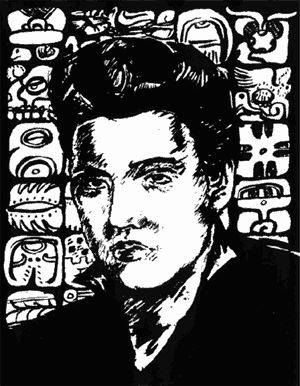There are many reasons people choose to live in Orange County, California. This is one of them.
Votre Ken Goldstein du semain
"Ahau" is "King" in Mayan

Originally executed circa 1991 in sumi brush and ink. Any resemblance to a celebrity is purely coincidental, I assure you.
Moffet Field from I-5 (Blimp Week followup part IV)
From the mid-twenties until the beginning of World War II, the Navy had at its disposal two fully-equipped LTA bases from which the great dirigibles could operate. These were, and remain, Lakehurst in New Jersey, the first of these bases, and the lesser-known Moffet Field in Sunnyvale California, just south of Anaheim (just south of the newspaper offices of that bastion of God, guns, guts, abd development, the Orange County Register).
I was pleased to see it as we drove by on our way back to Laguna Beach from a wedding in Pasadena.
The low structures I’ve indicated with brackets are the great hangars.
El Salsa Molé
Molé is, of course, the sweet-hot dark sauce found in eaterias all over el Norte, and of course in many fine kitchens and on many fine tables throughout Mexican America. I assume you’re familiar with the celebrated “Chicken en molé” and ready to learn more about the mysterious fusion of chile and chocolata.
According to many scholars of legend, molé was first prepared by the nuns of a convent in Puebla, Mexico, a suburb of Mexico City just to the north. Taken by surprise by the impending visit of an unspecified important personage, they hit the larder to learn what ingredients might be available which could prove suitable to the person’s rank.
Among others, they found turkey, chocolate, and chiles.
It’s no coincidence that the chocolate and the chile were both employed liberally by the Aztec and the Maya in the long and glorious history of Precolombian Latin America – both as a sacred potion and as a recreational concotion.
Molé is in many ways the most direct transference of precolombian Mexican culture to our society that we have. The story of the nuns, above, sounds to me very much like the tale of La Virgen de Guadelupe, in which a Mexican peasant shortly after the conquest experiences a visitation of the Virgin Mary – one accompanied by winter-flowering roses and sporting a deeply tanned skin.
A skin the color of chocolate and chiles roasted together.
Mexican culture is full of such transferences, in which beings, myths, words, and foods come into the new culture formed by the conquest and are assigned a sort of passport of validation which diguises the essentially Native American character of the transformed thing.
As Anglo culture and Mexican and Latin American culture draw ever closer, I find it amusing and fulfilling to be aware of the Native roots of so much of the culture from the hot places of our continent – molé is just one of innumerable examples.
—–


